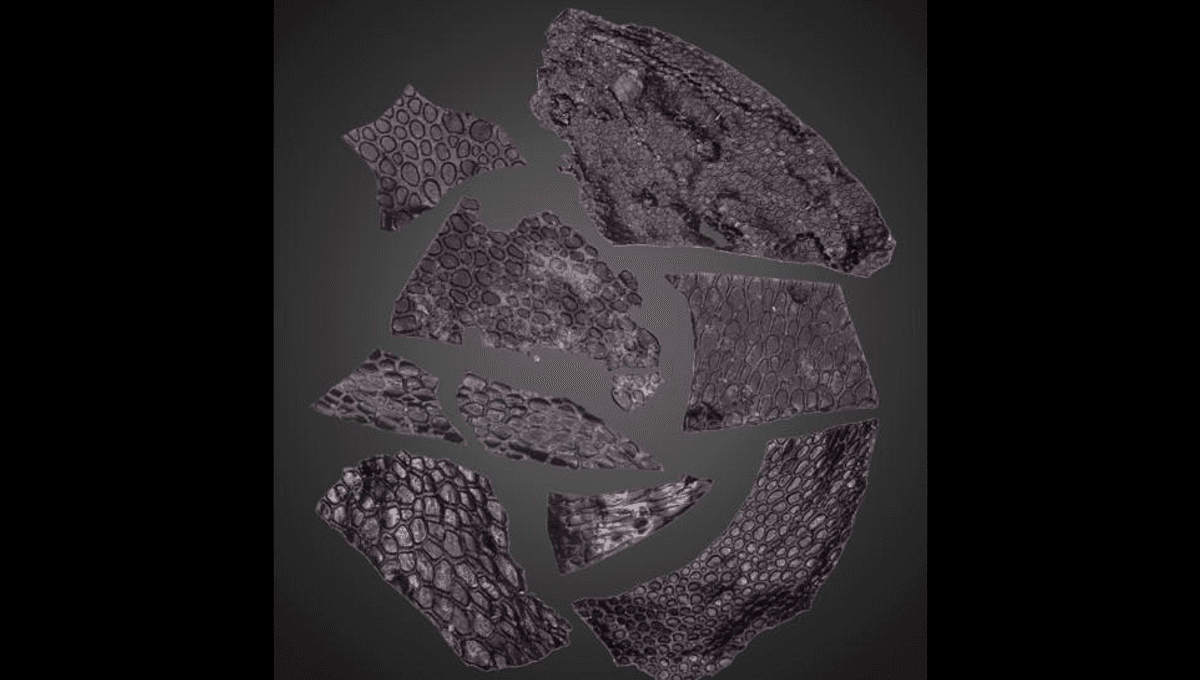
Fossilized skin from a reptile that lived at least 45 million years before the first dinosaur has been found. Although we know nothing else about the animal it came from, along with seven skin casts of similar age, the record-smashing discovery helps reveal the early evolution of skin.
Skin doesn’t fossilize well, so on the rare occasions we find some where the conditions were so perfect that it it did, the specimen is priceless. The further one goes back in time, the more likely it is that a fossil will have been destroyed by geological processes. Consequently, finding skin from the Paleozoic (539-252 million years ago) is so unlikely few fossil hunters even dream of it.
Yet it happened to a pair of amateur paleontologists, Bill and Julie May, who found part of the skin of a lizard from around 288 million years ago. The find was made in Oklahoma’s Richards Spur limestone cave system. It’s thought the lizard fell into what was already a cave at the time and a combination of low oxygen levels, clay sediments, and oil seepage preserved the skin.
“Every now and then we get an exceptional opportunity to glimpse back into deep time,” said Ethan Mooney, a graduate student at the University of Toronto, in a statement. Mooney had the privilege of being assigned the study of this specimen and other soft tissues from the caves as an undergraduate. “These types of discoveries can really enrich our understanding and perception of these pioneering animals.”
“Animals would have fallen into this cave system during the early Permian and been buried in very fine clay sediments that delayed the decay process,” Mooney added. “But the kicker is that this cave system was also an active oil seepage site during the Permian, and interactions between hydrocarbons in petroleum and tar are likely what allowed this skin to be preserved.”
Even with all this going for it, not much skin survived – less than the size of a fingernail. What did might be considered the skin equivalent of the platypus, combining features associated with wildly different modern species, as well as being a great survivor. Its pebbled surface is reminiscent of crocodile skin, but it also has hinged sections like those seen on snakes and legless lizards.
Although the skin survived, no bones or teeth made it from the unfortunate individual – a testament to how rare fossilization is – so we cannot identify the exact species of lizard. It may well be one that has never been scientifically described.
Although being able to identify the species would add a lot, Mooney says the discovery still shows how ancient aspects of modern reptile skin are. “The epidermis was a critical feature for vertebrate survival on land,” he said. “It’s a crucial barrier between the internal body processes and the harsh outer environment.”
The cave system in which the skin was found is the world’s richest source of land-living Paleozoic fossils, with hundreds of thousands of bones preserved by the same unusual combination of factors. Elsewhere in the system impressions in rocks carry the surface shape of ancient skin from several animals, seven of which have been described along with the fossil skin.
Mooney and co-authors describe these casts as revealing “striking variation”, indicating the preserved sample cannot be taken as representative of the era as a whole. Nevertheless, these impressions show that dermal scales, now found only in a few living amphibians, were standard at the time.
One particularly remarkable specimen reported in the same paper is a near-complete skeleton of a lizard-like Captorhinus aguti, accompanied by patterns the authors interpret as records of skin.
The study is published in Current Biology.
Source Link: Oldest Known Fossilized Skin Dates Back 45 Million Years Before First Dinosaurs